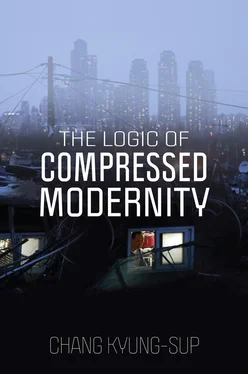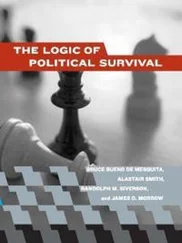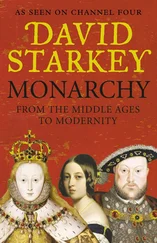As discussed in detail later in Chapters 2and 4, the multiple modernities thesis (Eisenstadt 2000) can be extended to the internal multiplicity of modernities across varying units or agencies of modernity in each national society such as individuals, families, secondary organizations, localities, as well as societal units. Such internal multiplicity on the one hand reflects the varying complexities of time–space (era–place) compression across different units of (compressed) modernity and, on the other hand, induces national modernity to take on an inherently complicated nature. Besides, the emphasis of Therborn’s (2003) entangled modernities thesis on “not just the co-existence of different modernities but also their interrelations” is directly relevant for the inter-unit interactive variability of (compressed) modernities discussed here. The authoritarian attribute of many postcolonial states in leading dependent modernization as often induces or intensifies this internal multiplicity of modernities as reduces or integrates it (see Chapter 4in this book). The recent globalization trend, despite its dominant neoliberal impetus, tends to necessitate subnational (and supranational) units to intensify their separate efforts and independent functions for actively coping with the floods of new risks and opportunities in the global age and thereby reinforce their status as units of compressed modernity (Chang, K. 2016a).
This book consists of three parts, respectively entitled: “Part I. Compressed Modernity in Perspective”; “Part II. Structural Properties of Compressed Modernity”; and “Part III. After Compressed Modernity.” Part I offers, besides the current introduction chapter, two chapters that respectively explain the definitional and universal aspects of compressed modernity. Part II includes six chapters that respectively deal with the internal multiplicity of modernities, the particular mode of citizenship under compressed modernity, the complexity of the cultural configuration of compressed modernity, the productionist bias and reproductive crisis in development, the social institutional deficits and infrastructural familialism, and the demographic configuration of compressed modernity. Part III concludes the current book with a chapter discussing South Korea’s post-compressed modern condition loaded with the dual burdens arising from, on the one hand, the earlier risky schemes of compressed modernization and development and, on the other hand, the common dilemmas accompanying social and economic maturation (or saturation). Although these diverse topics already constitute a sizable monograph, there are numerous other theoretical and empirical issues that need to be covered in order to provide a reasonably self-contained scientific account of compressed modernity. Nonetheless, this book is presented as a tentative general treatise on compressed modernity. Each of the above-mentioned chapters is briefly summarized as follows.
In Chapter 2, “Compressed Modernity: Constitutive Dimensions and Manifesting Units,” I intend to present a formal definition and core theoretical/historical components of compressed modernity. Compressed modernity consists of multiple dimensions constructed by all possible combinations of temporal (historical) and spatial (civilizational) manifestations of human social activities, relationships, and assets – namely, temporal condensation of historical change, spatial condensation of civilizational compass, compressed mixing of diverse temporalities (eras), compressed mixing of diverse spaces (civilizations), and interactions among the above. Compressed modernity can be manifested at various levels of human existence and experience – that is, personhood, family, secondary organizations, urban/rural localities, societal units (including civil society, nation, etc.), and, not least importantly, the global society. At each of these levels, people’s lives need to be managed intensely, intricately, and flexibly in order to remain normally integrated with the rest of society. Compressed modernity is a critical theory of postcolonial social change, aspiring to join and learn from the main self-critical intellectual reactions of the late twentieth century as to complex and murky social realities in the late modern world, including postmodernism, postcolonialism, reflexive modernization, and multiple modernities.
In today’s rapidly and intricately globalizing world, as shown in Chapter 3, “Compressed Modernity in the Universalist Perspective,” the driving forces of radical scientific-technical-cultural inputs and monopolistic political economic interests operate across national boundaries without serious obstacles. The liberal system transition of former state-socialist countries has intensified the globalizing nature of such inputs and interests. However, the ecological, material, and sociocultural risks accompanying the latest capitalist offense are not unidirectional (from developed to less developed nations) any more. Even developed nations cannot pass up the cosmopolit(an)ized hazards and pressures generated in the very process of their global economic and political domination over less developed nations. Managing these challenges, as well as exploiting the associated opportunities, by individual nations implies that internalization of cosmopolit(an)ized reflexivity takes place both in developed and less developed (capitalist and post-socialist) nations. Through this process, societies (or their civilizational conditions) are being internalized into each other, thereby making compressed modernity become a universal feature of national societies in the late modern world. In fact, the same is also true of individual communities, organizations, families, and persons.
As explained in Chapter 4, “Internal Multiple Modernities: South Korea as Multiplex Theatre Society,” modernity – and the process of modernization – can be plural not only across different national societies, as persuasively indicated in Eisenstadt’s “multiple modernities” thesis, but also within each national society. Korea has been particularly distinct in such internal multiplicity of modernities, including colonial dialectical modernity, postcolonial reflexive institutional(ist) modernization, postcolonial neotraditionalist modernity, free world modernity under the Cold War, state-capitalist modernity, cosmopolitan modernity under neoliberal economic globalism, and associative subaltern liberal modernity. These internally diverse modernities reflect a series of overpowering international influences and related local upheavals and confrontations to which Korean society and its people have been subjected since the late nineteenth century. Each of these modernities is not uniquely or exclusively Korean because they have been embedded in the global structures and processes of modern social change. Nevertheless, South Korea is certainly remarkable in the volume of multiplicities of modernities, the dramatic and intense realization of each modernity, the protracted operation of each modernity, and the extremely complex interactions among such multiple modernities. With all such impetuses and forms of modernities permanently extending their lifespan as variously embodied in the identites and interests of different generations, genders, classes, sectors, and/or regions, South Korea has been socially configured and reconfigured as a multiplex theater society in which all possible claims of modernities are aggressively and loudly staged side by side and/or one after another, however, without a clear clue to civilizational or sociopolitical reconciliation among them.
As detailed in Chapter 5, “Transformative Contributory Rights: Citizen(ship) in Compressed Modernity,” the life histories of most South Koreans since the mid twentieth century have been replete with dramatic institutional, developmental, sociopolitical, and ethnonational transformations and crises through which their nation and society have emerged with fully blown (compressed) modernity. In each of these drastic and fundamental transitions, South Koreans have had to confront not only the difficulties inherent in such radical transitions but, more critically, the troubles ensuing from the crude institutional conditions for managing them. While both the state and civil society were unstable, with their own survival remaining in question, the internal conditions and international environments required them to embark on, among other changes, rapid institutional and techno-scientific modernization and aggressive economic development. In fact, such transformations were often pursued in order to strategically trounce the sociopolitical dilemmas stemming from the inchoate, dependent, and even illegitimate nature of the state machinery and dominant social order. There have arisen transformation-oriented state, society, and population for which each transformation becomes an ultimate purpose in itself, the processes and means of the transformations constitute the main sociopolitical order, and the transformation-embedded interests form the core social identity . In this milieu, a distinct mode of citizenship has been engendered in terms of transformative contributory rights . Citizenship as transformative contributory rights can be defined as effective and/or legitimate claims to national and social resources, opportunities, and/or respects that accrue to each citizen’s contributions to the nation’s or society’s transformative purposes .As South Korea has been aggressively and precipitously engaged in institutional and techno-scientific modernization, economic development, political democratization, economic and sociocultural globalization, and, mostly recently, ethnonational reformation, its citizens have been exhorted or have exhorted themselves to engage intensely in each of these transformations, and their citizenship, constituted by identities, duties, and rights, have been very much framed and substantiated by the conditions, processes, and outcomes of such transformative engagements.
Читать дальше












